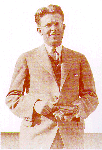
| In 1931, the American physicist Ernest O. Lawrence and his student Stanley Livingston built the first circular particle accelerator: the cyclotron. Things have come a long way since then - CERN's Large Electron Positron collider, the most powerful accelerator at the laboratory today, is some two million times more powerful than Lawrence and Livingstone's cyclotron. |